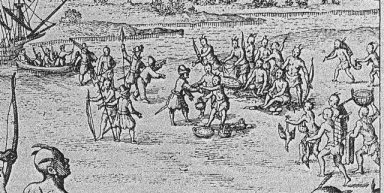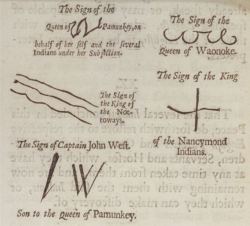 November 9-11, 1607
November 9-11, 1607
Chickahominies provided corn in trade to John Smith sufficient
to feed the settlers through the winter.
December 10, 1607
John Smith attempted to explore the upper
Chickahominy, was captured and spent a month in captivity.
Spring 1614
Chickahominies negotiated a Peace Treaty with
the English under which they promised to pay tribute to the
English in the form of corn and to supply warriors to fight
the Spanish.
1616
English attacked the Chickahominies when they
failed to pay tribute. Chickahominies paid ransom for captive
leaders. Opecancanough intervened between the Chickahominies
and the English.
March 1622
Chickahominies participated in the Great
Assault on the English settlements.
1622-1628
English waged systematic reprisals against
Native tribes forcing the Chickahominy to move up river.
1628
Peace
Treaty
1632
Peace Treaty
1644
Chickahominies participated in the
Second Great Assault on English settlements.
1645
English
attacked Ozinies, the one Chickahominy town remaining on
the lower Chickahominy River. Survivors
fled to upper Mattiponi River and to the Pamunkey Tribe.
1646
Necotowance’s
Treaty forced Indians out of the land between the James and
York Rivers. Chickahominies
moved to north side of Pamunkey River near modern-day West
Point.
1661
Chickahominies moved to new lands on the
upper Mattaponi near modern-day Aylett.
May 1677
First
Treaty of Middle Plantation was signed by the Queen of the
Pamunkey for the Chickahominy who objected
to this subjugation.
1702
Chickahominies lost their
land on the Upper Mattaponi and went to live with the Pamunkey
Tribe.
ca.1560
Paquinquineo was captured
by the Spanish and taken abroad and baptized Don Luis de
Velasco.
1570-71
Spanish returned with Don Luis
and established a mission on the York River. Don Luis returned
to his tribe
and the missionaries were killed.
May 5, 1607
Paspaheghs
entertained visitors from England.
May 13, 1607
English
settlers landed at Jamestown Island and built a Fort in Paspahegh
territory.
May 27, 1607
Paspaheghs attacked James
Fort.
May 1608
Paspaheghs captured Englishmen
hoping to trade for release of captured Paspaheghs. John
Smith burned
a Paspahegh village. 
Spring 1609
Paspahegh Chief
was captured and held prisoner as ransom for Germans living
with Powhatan. He escaped,
and John Smith retaliated by burning Paspahegh houses and
destroying fishing weirs.
August 1610
Paspahegh Chief’s
town was attacked. Chief’s family was killed, but he
escaped.
February 1611
Paspahegh Chief attempted
an ambush near James Fort and was killed.
May 1611
Paspahegh
disbursed to join other tribes.
May 26-27, 1607
Weynocks on both sides of the James River
entertained the English on their return from an exploratory
trip to the Falls.
1611
English settlements were planted
at Henrico and Bermuda Hundred in Weyanock territory.
1613
English
planters settled West and Shirley Hundred in the immediate
vicinity of the Weyanock Chief’s town
and two other Weyanock villages.
1617
Opechancanough gave
Sir George Yeardley 2,200 acres of Weyanock territory.
ca.1618
Tanks
Weyanock was settled by English planters.
1619
Westover and Berkeley
Town and Hundred were settled by English planters in Weyanock
territory.
ca.1620
Swinhow’s and Causey’s
Care, two more English private plantations, were settled
in Weyanock
territory.
March 22, 1622
Weyanocks participated
in the Great Assault on English plantations.
1622-1628
English
waged systematic reprisals against Native tribes forcing
the Weyanocks to leave their villages.
April 18, 1644
Weyanocks
participated in the Second Great Assault on English plantations.
ca.
1644
Weyanocks fled the James River area and
settled along the Roanoke River in modern day North Carolina.
1653
Weyanocks
moved to Nottoway River near Courtland, Virginia.
1661(2)
Weyanocks
appealed to English for protection from Nansemond attacks
and stayed with the English for two
years within the Blackwater Boundary.
1664
Weyanocks returned
to the Roanoke River.
 |
Articles of Peace, printed by John Bill, Christopher Barker, Thomas Newcomb and Henry Hills, London 1677. Courtesy Special Collections, Earl Gregg Swem Library, College of William and Mary. |
1667
Weyanocks moved to settle
on the Meherrin River and again sought asylum with the
English.
ca.1670
Weyanocks purchased land from the
Tuscaroras on south side of Blackwater River, slightly west
of Waverly,
Virginia.
May 1677
Weyanocks signed the first Treaty
of Middle Plantation.
1693
Weyanocks abandoned their
settlement and dispersed to live with the Nansemonds and
the Nottoways.
next Time Line
